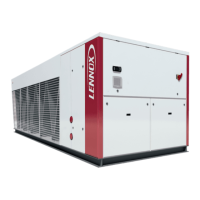• 5 •
3,40
3,60
3,80
4,00
4,20
4,40
4,60
270 300 340 370 420 480 540 600
kW
ESEER
NEOSYS
Application Guide /NEOSYS-AGU-1801-E
Screw R134A units
Scroll R410A units
FEATURES AND BENEFITS
A high energy performance
By using R410A refrigerant associated with high effi ciency micro
channel coils and variable speed fans NEOSYS is contributing to
a very low energy consumption all year around with an average
energy effi ciency ratio (ESEER)* in cooling mode above 4.0.
NEOSYS Heat-pumps are also achieving very high performances
in cooling and heating mode (COP* up to 3.2).
Furthermore NEOSYS advanced control allows energy savings
all year around by using smart control functions:
- Low water system quantity to reduce the time to reach the set-
point.
- Dynamic defrost (patented) to limit the number of defrost cycles.
- Set-point reset based on outside air temperature to relax the
chilled water set-point.
*ESEER : European Seasonal Energy Effi ciency Ratio in cooling mode.
COP : Coeffi cient of Performance in heating mode.
R410A Micro channel heat exchanger
With the use of fully
aluminium coils already
used in the automotive
industry, NEOSYS offers
many customer benefi ts:
- Up to 40% less refrigerant
charge that contributes to
reduce the total amount
of refrigerant used in the
system.
- A more effi cient system
(EER + 10%).
- An air heat exchanger
with signifi cantly impro-
ved corrosion resistance
results (x 2) from the
same aluminium alloy (no galvanic action) vs. the traditional
copper tube/aluminium fi n coils. By using this type of coil, units
can be used in light corrosive or seacoast environments without
any need for additional, and expensive, pre-treated fi ns or coil
coating.
- High mechanical resistance eases the cleaning with high pressure
air or water washers without any risk of damaging the fi ns.
Available in cooling only version, this technology will surely be
enlarged shortly to reversible applications.
Floating high pressure
LENNOX optimizes the performance of the NEOSYS chillers with
electronic expansion valve (as an option) and variable speed
ventilation (as standard) to achieve maximum energy savings.
We defi ne a condensation temperature depending on the outside
air temperature at an optimum value to obtain the lowest power
inputs of couples, compressors and condenser fan motors.

